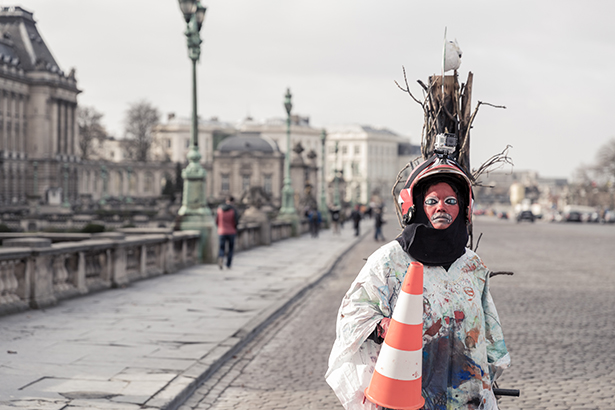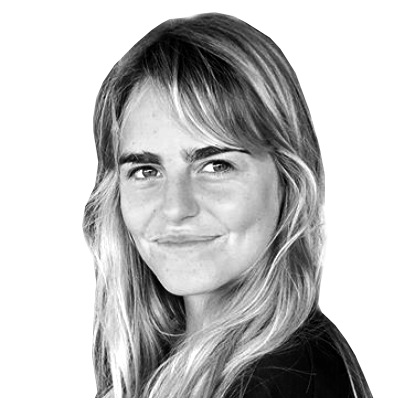Tracey Rose was born in 1974 in Durban, a city on the Eastern coast of South Africa. When she was a child in Johannesburg, apartheid was in full effect. Rose defied categorization, hovering between “Black” and the slightly more favorable classification “colored.” The art world captivated her, but a visit to the 1995 Johannesburg Biennale, where she encountered non-Western artists of color, cemented her resolve to be an artist. She, too, was going to make statements.
Outrage permeates Rose’s radical performance, video, and photographic work. In Ciao Bella, a video riff on Leonardo’s Last Supper, she performed 13 different roles and made waves at the 2001 Venice Biennale. In 2005’s The Hope I Hope, Rose filmed herself peeing on the Palestinian–Israeli border in a tutu. Ahead of this week’s opening of her retrospective at the Queens Museum, AIR MAIL chats with the artist.

ELENA CLAVARINO: What was it like growing up during apartheid?
Tracey Rose: They would stick a pencil in your hair to determine your race. If it slid out you were classified white, if it stayed in, you were classified Black or colored, meaning your hair was kinky, so it could hold the pencil.
E.C.: When did you know you were an artist?
T.R.: I had to draw a Last Supper for school and my mum ended up drawing it for me. The next day when we were comparing drawings everybody was like, “Tracey’s Last Supper is the best.” I had to draw 10 Last Suppers that day. It was an all-white school so I was crying inside. I was so terrified. Then I realized like, shit, this is how you get respect.
E.C.: I’ve read that you refer to yourself as a failed painter.
T.R.: I’m a frustrated painter, not a failed painter. I had these statements to make and performance is immediate. The first time I saw Julie Mehretu’s painting, I was dumbfounded. But oil paint is expensive, while the human body and gesture isn’t. It’s immediate, and the body just needs to be fed.

E.C.: You’ve been compared to Cindy Sherman. Is she an inspiration of yours?
T.R.: She was initially, but she didn’t go far enough. White practitioners often exist in comfort with the knowledge that the system is designed for them. Then I came across Samuel Fosso’s incredible self-portraits and they held so much more power.
E.C.: How has your heritage informed your work?
T.R.: My ancestral lineage is very much indigenous African. My ancestors were painting in caves. Before museums, and before record deals, they were making music, they were dancing. For me, art is not even about the theory or the medium, it’s about the vibration, the frequency, the ripple that comes out of that intention, the spell that gets cast. I’m just a messenger. I get physically ill if I don’t create the work that I’m supposed to.
E.C.: What do you think the artist’s role is in the world?
T.R.: We’re like the jester who moves with the king and the nobility and aristocracy, as well as the so-called peasantry. Jesters interrogate, perform, mock, and inform. The only people that are more powerful in terms of radical space are standup comedians. My ultimate fantasy is to be a standup comic.

E.C.: What’s your working process?
T.R.: At one point, it was a two-year process from its conception. From the minute I got the idea, I would tear it apart. Then a friend of mine said, “Why don’t you just trust yourself?” So with Ciao Bella I let instinct take over. I was in Cape Town and looked at Table Mountain and said to my ancestors, “If you exist, make this work.” And they fucking did. It was so perfect in every aspect. It terrified me.
E.C.: You are also into non-Western occultism and exorcism.
T.R.: I’ve been doing ayahuasca journeys for the past 15 years, near Lesotho. Every time I’ve done ayahuasca [a plant-based psychedelic], Native American energies come up. I call it the Ayahuasca Spirit University.
E.C.: Aside from Shooting Down Babylon, the central work in your retrospective, is there anything in particular you’re excited about showing at the Queens Museum?
T.R.: My first solo was in New York, so I feel like I’ve come full circle, back to my artistic home. Queens reminds me of old-school New York, the way I encountered it in the 90s. I’m looking forward to going back to those foundational works. When I was doing it, it was myself and Stephen Cohen and Nina Romm. That was it. Now everybody in this country’s doing performance art. That wouldn’t have happened if I hadn’t sat naked in that cabinet in Span II, 1997. Does the fucking work speak beyond boundaries? That’s what art is supposed to be.
“Tracey Rose: Shooting Down Babylon” will be on at the Queens Museum, in New York, beginning April 23
Elena Clavarino is the Senior Editor for AIR MAIL

